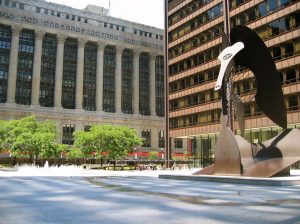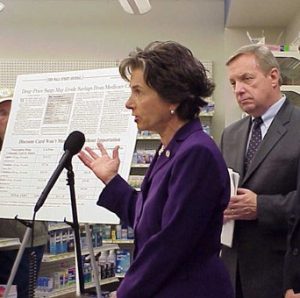The Illinois state tree, the White Oak or Quercus alba, is more than just a tree.
Its thick trunk and sturdy branches provide high-grade wood used to produce an array of products.
The leaves–with around five to nine bulbs each resemble a hand with too many fingers–and the bark are used by some for herbal supplements and astringents.
Those same leaves filter the air and produce oxygen for us to breathe, as well as offer a shaded paradise for a snooze on a summer day.
But Illinois may want to come up with a backup for its official tree, because the White Oak species may not survive in the state in the years to come if climate change pans out the way some experts believe.
An increasing number of cases are already appearing in the scientific literature documenting changes in species patterns across the U.S. due to climate change such as the timing of migration, flowering dates and timing of appearance or disappearance, according to a 2009 United States Department of Agriculture Forest Service’s study, “Potential Changes in Tree Habitat for Illinois under Climate Change.”
Environmental scientists in Illinois and the Midwest have begun to predict how climate change will affect local vegetation, and in the White Oak’s case, among many other tree species, it’s not looking good.
Based on future climate change models, “most of the projections have the dominance of White Oaks in Illinois decreasing,” said Robert Fahey, forest ecologist at the Morton Arboretum, located in Lisle, Ill.
White Oaks—which can grow up to 100 feet—are common throughout Illinois and the Midwest, but are most abundant in Southern Illinois and Missouri.
According to Fahey, the White Oak has a wide tolerance to varying temperatures. The oaks probably won’t disappear from Illinois solely due to the predictive rates of warming, he said.
So if rising temperatures aren’t the White Oak’s problem, what is?
“Some of the secondary effects could be a big problem,” Fahey said.
These secondary effects include invasive plants, pests and pathogens, which may be exacerbated by climate change—although this is still a topic of uncertainty among experts, according to Fahey.
“Pests and pathogens are currently a problem for oaks that could become more of a problem,” Fahey said.
One pest, the gypsy moth—which builds cocoons in the trees and then the caterpillars eat the leaves—currently has massive population outbreaks on the White Oak.
Gypsy moths won’t kill the trees alone, but “if the trees are stressed because of other reasons due to climate change and precipitation that interaction could make the White Oak become more susceptible to the gypsy moth,” Fahey said.
One plant pathogen that could destroy the species is Phytophthora ramorum, known as Sudden Oak Death. This pathogen caused the Potato Blight in Ireland from 1844-1849, according to Fahey. Sudden Oak Death attacks many oak species. According to Fahey, researchers first noticed the pathogen damaging oaks—hence its name.
Rising global temperatures will also cause southern species of trees and other vegetation to migrate north, according to David Goldblum, assistant professor of geography at Northern Illinois University, who has authored multiple papers that predict the effects of climate change on local tree species.
This big move has been documented in the past, he said.
“During the last ice age most of the Canadian and the Great Lakes plants had spent the ice age in the southern U.S. for almost 100,000 years,” Goldblum said.
“As the climate warmed up everything shifted northward.”
As the current climate begins to warm, southern species living in states such as Arkansas and Mississippi, which normally can’t tolerate frost and northern winters, will begin to move to Illinois and the surrounding states.
“The Great Lakes region will be more habitable for those southern species that wouldn’t be here if it weren’t for human-induce climate change,” Goldblum said.
Goldblum said these southern species will change the composition of Illinois’ forests and may decrease the White Oak’s dominance.
“This will likely have a negative impact on the growth of White Oak,” Goldblum said.
The White Oak will become less competitive and reproduce less, he said.
According to Neil Hendrickson, director of Bartlett Tree Research Laboratories in Charlotte, N. C. and expert arborist, this is an example of ecosystem simplification.
“The forest will still be green, but it will be different,” he said.
But how will rising CO2 emissions affect the White Oak?
The actual CO2 enrichment is not something that worries Fahey or Goldblum as something detrimental to an individual tree species.
“People often talk about this CO2 emissions issue,” Fahey said.
“CO2 will make the trees more productive.”
The dilemma however, is that some tree species will be able to deal with that CO2 enrichment more than others. As a result, those species may out compete Illinois’ native trees and change the forest composition—the same ecosystem simplification scenario Hendrickson said if temperatures rise.
Hendrickson said although trees thrive with CO2, humans have already past the tipping point, and the solution of planting more trees will not fix the problem.
“If we turned off the tap now, carbon’s half life is 100 years,” said Hendrickson.
“Whatever we have already done, the effects will continue for 100 years.”
Hendrickson stressed that with CO2 emissions “there is no free lunch”—one of the four laws of ecology.
“You want to burn a lot of fossil fuels? You will have to pay,” Hendrickson said.
“Where does the CO2 go? No place good.”
The breathable air in the atmosphere is only two miles thick, he said.
“It’s about as thin as a piece of paper,” Hendrickson said.
“We don’t have a lot of air to work.”
Because 100 years is so distant, it’s typically hard for people to make a sacrifice and change their ways, Goldblum said.
“It’s hard for people to think in the long term,” he said.
“People still smoke cigarettes even though they know it will negatively affect them in the future. But it’s hard to think in those terms.”
But if people do not work to save the White Oak and the other tree species, the future damage may not be reversible, Goldblum said.
“When we see the changes it will be difficult to correct past mistakes,” he said.
However, one of the promising engineering solutions to help mitigate climate change and protect the trees is biochar, which many scientists are currently experimenting with, Hendrickson said.
Biochar is a type of charcoal made from pyrolysis– the decomposition of organic materials in high temperatures with little oxygen. This charcoal is not used for fuel but instead absorbs carbon.
Hendrickson said biochar sequesters carbon “like nobody’s business.” When a tree is planted in biochar, it can take in 20 percent more carbon than a normal tree, he said.
“The stuff is a permanent source of carbon in urban soil,” he said.
“It gives a stable source of carbon for years and creates a bio gas to run the process. That makes it a true miracle.”













Be First to Comment